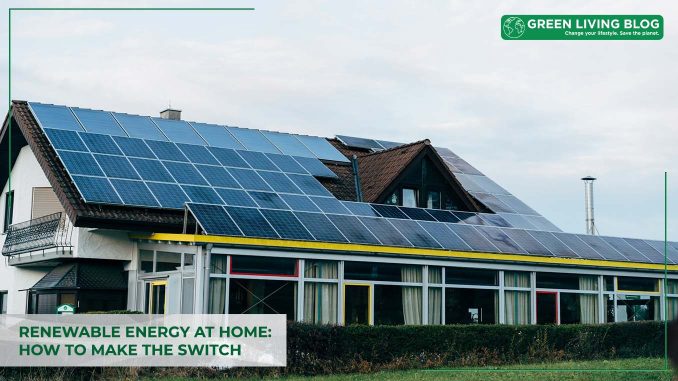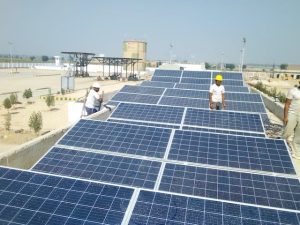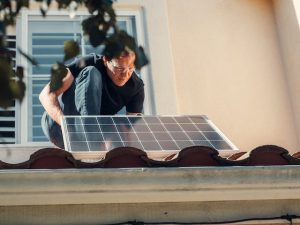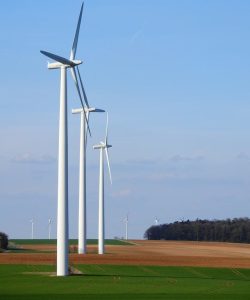
In an era where environmental sustainability is more crucial than ever, renewable energy stands at the forefront of transformative solutions.
Adoption of renewable energy in residential settings is a significant step towards reducing carbon footprints, harnessing natural resources, and fostering a sustainable future.
The purpose of this blog is to provide a guide to the process of integrating renewable energy into your home. This guide is designed to help beginners navigate the transition to renewable energy.
From understanding the basics of how these systems work to practical tips on installation and maintenance, we’ll cover everything you need to know to make an informed and impactful switch to greener energy solutions in your home.
What is Renewable Energy?

Renewable energy, at its core, is energy derived from natural processes that are continually replenished. This includes power generated from the sun, wind, water, and geothermal heat.
Unlike traditional energy sources such as coal, oil, and natural gas, renewable energy sources do not deplete over time and are inherently more sustainable. They differ significantly from fossil fuels in both their impact on the environment and their long-term availability.
The benefits of using renewable energy are multifaceted:
- It offers a cleaner alternative, significantly reducing greenhouse gas emissions and air pollution.
- Renewable energy can lead to substantial cost savings over time. The cost continues to decrease over time.
- Governments offer incentives, tax credits, and rebates to encourage the adoption of renewable energy, further offsetting the initial costs.
Its sustainable nature, coupled with the benefits of reduced emissions and potential cost savings, makes renewable energy an increasingly attractive option for homeowners looking to make a positive impact.
Assessing Your Home’s Renewable Energy Potential

Evaluating your home’s suitability for renewable energy involves considering several key factors that can significantly influence the effectiveness and efficiency of the energy system you choose to install.
Before you make the decision to go solar or wind, consider the following:
Location:
Your geographic location plays a pivotal role in determining the type of renewable energy source most suitable for your home. For instance, homes in sunny regions are ideal candidates for solar energy systems, while properties in windy areas might benefit more from wind turbines. The amount of daily sunlight or wind your location receives directly impacts the potential energy output of these systems.
Climate:
The local climate is another important consideration. Extreme weather conditions, such as heavy snowfall or frequent storms, can affect the performance and maintenance needs of renewable energy installations. For solar panels, factors like the angle of the sun and the number of daylight hours across different seasons will influence energy production.
Property Size and Layout:
The size and layout of your property can also determine the feasibility of installing renewable energy systems. Solar panels, for example, require sufficient roof space with the right orientation and inclination to maximize sun exposure. Similarly, wind turbines need enough open space and height to operate efficiently. Assessing your property’s layout and available space is essential in planning for renewable energy installations.
Roof Condition and Age:
Specifically for solar energy, the condition and age of your roof are critical. A roof that is near the end of its life, or one that requires significant repairs, might not be ideal for solar panel installation until these issues are addressed.
By carefully evaluating these factors, you can determine the most suitable renewable energy options for your home and ensure that your investment is both practical and effective. This assessment is a vital step in making an informed decision about transitioning to renewable energy and reaping its long-term benefits.
Solar Energy at Home

Solar energy has emerged as a leading choice for residential renewable energy, thanks to its accessibility, efficiency, and increasingly affordable technology.
Harnessing the power of the sun to generate electricity, solar panels offer a sustainable solution to meet household energy needs while reducing reliance on traditional power grids.
How does solar work?
Solar panels work by converting sunlight into electricity. This process, known as photovoltaic (PV) conversion, involves solar cells made of semiconductor materials, typically silicon. When sunlight hits these cells, it causes electrons to be set in motion, creating an electric current. This current is then used to power your home or fed back into the electricity grid.
There are several types of solar panels available, each with its own set of characteristics and efficiency levels.
The most common types include monocrystalline, polycrystalline, and thin-film solar panels.
Monocrystalline panels, known for their high efficiency and sleek appearance, are made from a single, continuous crystal structure.
Polycrystalline panels, slightly less efficient but more cost-effective, are made from multiple silicon crystals.
Thin-film panels, flexible and lightweight, offer lower efficiency but can be a good option for certain applications.
Installation considerations
When considering solar panel installation, several factors need to be considered to ensure optimal performance and viability.
Roof Condition:
The condition of your roof is paramount. Solar panels typically have a lifespan of 25-30 years, so your roof should be in good condition and able to support them for this duration. Any necessary repairs or replacements should be addressed prior to installation.
Roof Orientation and Angle:
The orientation and angle of your roof affect how much sunlight your solar panels will receive. In most cases, a south-facing roof without shade and at an angle of about 30-40 degrees is ideal for maximizing solar energy production.
Local Regulations and Incentives:
It’s important to be aware of local regulations, permits, and incentives. Many regions offer tax credits, rebates, and other incentives for solar panel installation, which can significantly offset the initial costs. Additionally, understanding local zoning laws and building codes is crucial to ensure compliance.
In summary, solar energy presents a practical and eco-friendly option for homeowners looking to embrace renewable energy. With the right setup and consideration of key factors like roof suitability and local regulations, solar panels can significantly contribute to reducing your carbon footprint and achieving energy independence.
Wind Energy for Residential Use

In the realm of residential renewable energy, wind turbines emerge as a compelling alternative or complement to solar energy.
These systems harness the power of the wind to generate electricity, offering an efficient and sustainable energy solution for homeowners.
Understanding Small-Scale Wind Turbines
Residential wind turbines are designed to be smaller and more suitable for individual homes compared to their larger counterparts used in wind farms. These turbines convert the kinetic energy of the wind into mechanical power. This mechanical power then drives a generator that produces electricity for home use. The efficiency of a wind turbine largely depends on wind speed – generally, higher speeds result in more power generation.
Small-scale wind turbines come in various designs, with the most common being the horizontal-axis turbines, which resemble traditional windmills. Vertical-axis turbines are another option, often chosen for their smaller footprint and lower wind speed requirements.
Suitability for Different Properties:
The suitability of wind turbines for a residential property depends on several factors. Key among these is the average wind speed in the area. Generally, locations with average wind speeds of at least 10 miles per hour are suitable for wind energy generation. The property should also have enough open space to accommodate the turbine, which needs to be placed in an area free from obstructions that could block or divert the wind.
Installation Considerations:
When considering the installation of a residential wind turbine, there are several important factors to consider:
Space Requirements:
Adequate space is crucial for the installation of a wind turbine. The turbine should be positioned high enough to catch the wind, typically requiring a tower that is tall enough to elevate the turbine above any obstructions.
Local Wind Conditions:
Understanding the local wind patterns and speeds is essential. This information can often be obtained from local weather services or through a professional assessment.
Permits and Regulations:
Just like with solar panels, installing a wind turbine may require navigating local zoning laws and obtaining necessary permits. It’s important to check with local authorities about any regulations or restrictions that might apply.
Grid Connection and Off-Grid Options:
Homeowners need to decide whether to connect the turbine to the electrical grid or use it for off-grid energy generation, often with battery storage.
In summary, residential wind turbines offer a viable option for homeowners looking to harness renewable energy. While they require careful consideration of local wind conditions and space requirements, they can significantly contribute to a home’s energy independence and environmental sustainability.
Financial Considerations
Embarking on the journey of installing renewable energy systems involves an understanding of the financial landscape, encompassing initial investments, available incentives, and long-term economic benefits.
Initial Costs:
The upfront cost of installing renewable energy systems, such as solar panels or wind turbines, is a crucial consideration. These costs can vary widely based on the type and scale of the system, the complexity of the installation, and the specific technology used. For solar energy, for instance, the price will depend on the number and type of panels, the size of the system, and additional equipment like inverters and battery storage systems. Similarly, for wind energy, factors like the size of the turbine and the tower height play a significant role in determining the cost.
Government Incentives and Rebates:
To encourage the adoption of renewable energy, many governments offer a range of incentives, tax credits, and rebates. These financial incentives are designed to make renewable energy systems more affordable and accessible to a broader population. Tax credits can significantly reduce the amount of tax you owe, while rebates may provide direct refunds post-purchase. Additionally, some regions offer feed-in tariffs, paying homeowners for excess energy generated by their renewable systems and fed back into the grid.
Long-Term Financial Benefits:
While the initial investment can be substantial, the long-term financial benefits of renewable energy systems are compelling. The most immediate benefit is the reduction in monthly energy bills. Over time, the savings accrued from lower utility costs can cover and even exceed the initial installation expenses. Furthermore, renewable energy systems can increase property value, making homes more attractive to environmentally conscious buyers. The potential for selling excess energy back to the grid can also provide an additional revenue stream for homeowners.
![]()
Author Profile
- Online Media & PR Strategist
- Blogger and Educator by Passion | Senior Online Media & PR Strategist at ClickDo Ltd. | Fascinated to Write Lifestyle Blogs in News & Education I have completed a journalism summer course at the London School of Journalism and manage various blogs.
Latest entries
 LeisureApril 16, 202510 Best Green UK Hotels for Eco-Tourists
LeisureApril 16, 202510 Best Green UK Hotels for Eco-Tourists Best practicesApril 14, 20258 Best Ways to Reduce Your Carbon Footprint
Best practicesApril 14, 20258 Best Ways to Reduce Your Carbon Footprint Green Expert GuidesMarch 28, 2025Lisbon Living: Where Sustainable Charm Meets Urban Energy
Green Expert GuidesMarch 28, 2025Lisbon Living: Where Sustainable Charm Meets Urban Energy EnvironmentJanuary 21, 2025Buying Eco-Friendly Homes: 6 Eco Questions to Ask Your Real Estate Agent
EnvironmentJanuary 21, 2025Buying Eco-Friendly Homes: 6 Eco Questions to Ask Your Real Estate Agent






Leave a Reply
You must be logged in to post a comment.